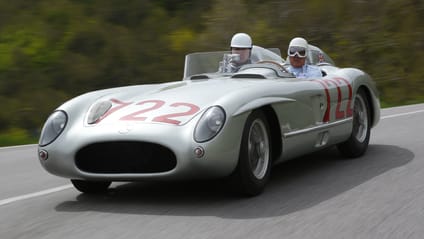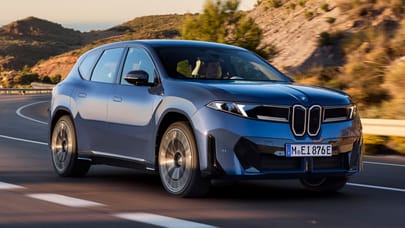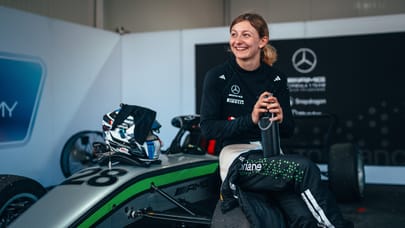
Top Gear’s coolest racing cars: Mercedes 300 SLR
The car that produced the greatest drive of them all? TG quizzes Sir Stirling Moss


The 2016 edition of the fearsome Italian Mille Miglia road race kicks off later this week. Obviously the modern incarnation isn’t as fearsome as the original, which ran from 1927 to 1957, bar a period in the 1940s during which motorsport was the last thing on anyone’s mind, and technically it’s not a race these days, either (though try telling that to some of the participants).
Alfa Romeo and Ferrari both owe a large chunk of their reputation to their multiple successes in this gruelling marathon, but one car – and one performance – eclipsed all others. That would be Stirling Moss’s drive in 1955 in the Mercedes 300 SLR, a truly glorious elision of man, machine and the sort of race that no one would dream of running nowadays. As TG.com has previously noted, this is arguably the greatest competitive drive of all time, a mix of superhuman talent and improvisational skill that saw Moss and navigator Denis Jenkinson complete the race in 10 hours seven minutes and 48 seconds, at an average speed of 98mph. In 1955. (The British duo finished 32 minutes ahead of second-placed Juan Manuel Fangio, in the other 300 SLR – he did the race without a co-driver…)
Advertisement - Page continues below
Mercedes’ itself was a magnificent operation in the 1950s. The W196 Silver Arrows dominated Formula One in 1954 and ’55, and effectively sired the 300 SLR to repeat the feat in sports car racing. The groundbreaking 2.5-litre V8 was bored and stroked to almost three litres, increasing the power output to well over 300bhp while shovelling out enough torque to fell a Tuscan forest.
The engine was angled slightly to the right, and mounted just behind the front axle; these measures promoted more effective weight distribution and improved aerodynamics. The SLR was also noted for its desmodromic valves (using cams and actuators rather than return springs to avoid valve ‘float’ and loss of performance) and direct fuel injection, marking it out as an impressive technological accomplishment for the era. An aluminium spaceframe chassis was clothed in lightweight magnesium alloy (or Elektron) body panels, bigger brakes were fitted, and it had double wishbones upfront.

Fuelling the beast required a potent blend of high octane fuel, benzene, and sometimes alcohol. Not only that, but the 300 SLR’s tank could swallow 250 litres of fuel or more, with understandable consequences for its handling balance (as Sir Stirling remembers – see the coming slides for quotes from the great man).
Now imagine piloting this thing at speeds in excess of 160mph on perilous Italian public roads, while picking off your fellow – and mostly lesser – competitors. It’s worth noting that the 300 SLR also triumphed on the equally tricky roads of Ulster (in the TT at Dundrod) and Sicily (on the Targa Florio), although the tragedy at Le Mans in 1955 understandably casts something of a shadow over that year’s sports car campaign.
(NB: The 300 SLR is one of those cars whose legend is inextricably linked to its creator, in this case Rudolf Uhlenhaut, the London-born technical director of Mercedes’ motorsport department, and a driver and engineer of almost equal ability.)
Advertisement - Page continues belowSir Stirling Moss… on the 300 SLR
“There weren’t many cars that could win the Mille Miglia – you need to be very fast, very strong, and have proper organisation behind it. So it does take a fairly unique machine. Now, if I was choosing a car to go round Monaco in, I certainly wouldn’t choose a 300 SLR. It was a large car, not adaptable. But it was well suited to the Mille. It was reasonably economical… we were getting eight or nine mpg, which at the speeds we were going was not bad at all. We refuelled; stopped at Pescara and threw in five gallons. The whole back of the thing was basically fuel and the car handled differently when we arrived at Rome empty then left fully fuelled. It affects performance, too, when you bung on that much fuel. My tyres were maybe just six inches wide, which means there were certain limitations in terms of adhesion… you were continually correcting, yes.”
…On the rival cars

“The 300 SLR was a terrific car. So were the Aston Martin DBR1, the Jaguar D-type and the Birdcage Maserati, but nothing like the SLR. It’s the only car I can think of where I could have achieved what I did – I don’t think I could have done it in any other car. It was so strong. There was one car in the event that year that had the speed – Castellotti’s Ferrari [121 LM Scaglietti]. Very fast driver, that boy, and he came past me, left a couple of black marks on the road. And I thought, “well he’s not going to last. Take a car like that and drive it that hard, it’s not going to last.” [It didn’t, Castellotti’s car expired near Pescara]
…On getting airborne

“We went over a hump-backed bridge. Jenks had given me the signal that it was OK. We went over this damn thing at 150 or 160mph. In practice, you see, we probably hadn’t gone any faster than 120mph. Well, at 160 we took off and the bloody thing was flying. It was a dead straight road, but I knew it was a bit dodgy. We were airborne for quite a few seconds. The steering obviously went a bit light… and we landed and Jenks and I looked at each other and just went [rather quizzical expression crosses his face]. We certainly had our moments…”
…On Mercedes

“My relationship with Mercedes was very good. Uhlenhaut had an English mother, and spoke perfect English. [Alfred] Neubauer [Mercedes’s F1 racing manager] was a fabulous character, a father figure really, and had a great sense of humour. The organisation was so good. I remember driving round Monza on the banking following Fangio, when the windscreen broke. I came in pointing at a non-existent bit of glass and 39 seconds later a new one was fitted. Next race, if one got broken I’d push a button and another one would flip up! They were incredible. If I wanted my steering wheel a bit bigger or smaller, they’d do it. We had 56 mechanics, which was unbelievable then. Mercedes in that period revolutionised the sport.”
Advertisement - Page continues below…On the deal

“My Merc contract entailed F1, Mille Miglia, Targa Florio, TT, Le Mans… I had to race in all of them under the contract. I got $20 a day to live on, and an extra $1 to clean the car because a Mercedes driver was expected to have a clean car. I thought I’d wash it myself and keep the $1.”
Mercedes 300 SLR

Year: 1955
Drivers: Stirling Moss, Juan Manuel Fangio
Engine: 3.0-litre, eight-cylinder, 300bhp-plus
Performance: 186mph top speed
Weight: 900kg
Stand-out moment: easy – 1955 Mille Miglia
Advertisement - Page continues below
Trending this week
- Car Review
BMW 1 Series







